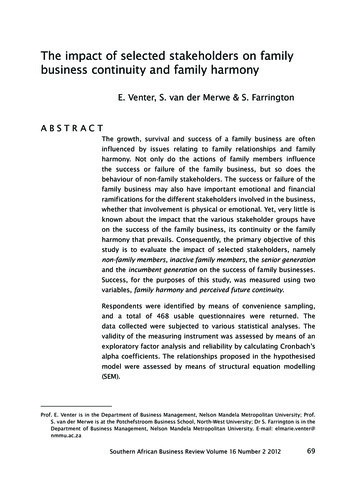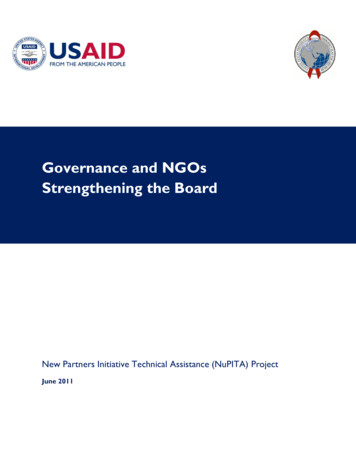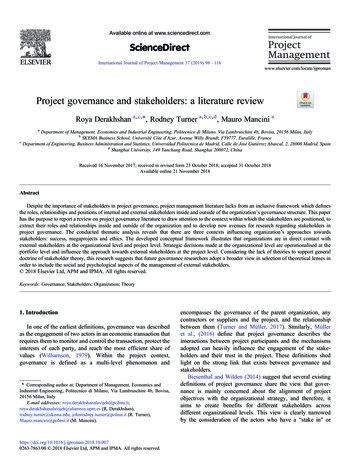
Transcription
The impact of selected stakeholders on familybusiness continuity and family harmonyE. Venter, S. van der Merwe & S. Farrington4ABSTRACTThe growth, survival and success of a family business are often8influenced by issues relating to family relationships and familyharmony. Not only do the actions of family members influencethe success or failure of the family business, but so does thebehaviour of non-family stakeholders. The success or failure of thefamily business may also have important emotional and financialramifications for the different stakeholders involved in the business,whether that involvement is physical or emotional. Yet, very little isknown about the impact that the various stakeholder groups haveon the success of the family business, its continuity or the familyharmony that prevails. Consequently, the primary objective of thisstudy is to evaluate the impact of selected stakeholders, namelynon-family members, inactive family members, the senior generationand the incumbent generation on the success of family businesses.Success, for the purposes of this study, was measured using twovariables, family harmony and perceived future continuity.Respondents were identified by means of convenience sampling,9and a total of 468 usable questionnaires were returned. Thedata collected were subjected to various statistical analyses. Thevalidity of the measuring instrument was assessed by means of anexploratory factor analysis and reliability by calculating Cronbach’salpha coefficients. The relationships proposed in the hypothesisedmodel were assessed by means of structural equation modelling(SEM).Prof. E. Venter is in the Department of Business Management, Nelson Mandela Metropolitan University; Prof.S. van der Merwe is at the Potchefstroom Business School, North-West University; Dr S. Farrington is in theDepartment of Business Management, Nelson Mandela Metropolitan University. E-mail: elmarie.venter@nmmu.ac.zaSouthern African Business Review Volume 16 Number 2 201269
E. Venter, S. van der Merwe & S. Farrington10The empirical results of this study reveal that family harmonyinfluences the perceived future continuity of family businesses. Inturn, inactive family members and the incumbent generation havea significant impact on the family harmony that exists in the familybusiness.Key words: family business, inactive stakeholders, active stakeholders, continuity,11family harmonyIntroduction and primary objectiveIt is well known that family businesses derive their special nature from the influenceof family on business (Hall & Nordqvist 2008; Leach 2007). The complicateddynamics that exist among family members not only influence the performanceof their family business but also its growth, change and transitioning over time.Interpersonal dynamics among family members have been identified as a criticalfactor in the low number of successful multi-generational transfers among suchbusinesses (Farrington, Venter & Boshoff 2010). In turn, the dynamics of the familybusiness also affect the well-being of the family (Olson, Zuiker, Danes, Stafford,Heck & Duncan 2003), and the family should be clear about the positive link betweenthe longevity of the business and the well-being of the family (Ibrahim, McGuire &Soufani 2009; Venter & Boshoff 2006). Family business leaders know that when theyencounter difficulties in the business, such as conflict between family members, boththe success of the business and the relationships among family members are at risk(Visser & Strydom 2010).Issues pertaining to family relationships have been identified as the primarythreat influencing the growth, success and survival of these types of businesses. Itis from conflict-laden family relationships that many family issues emanate (Molly,Laveren & Deloof 2010), and managing both the family and the business appearsto be a constant challenge facing family business owners (Schuman, Stutz & Ward2010). For families to add value and not poison the business, attention needs to bepaid to family relationships (Gordon & Nicholson 2010). Therefore, taking thesefamily dynamics into account (Ibrahim et al. 2009) is vital when researching familybusinesses.It is, however, not only family members that influence the success of the familybusiness, but also non-family members (including non-family employees) (Claver,Rienda & Quer 2009; Eybers 2010; Poza 2010). Sundaramurthy (2008) and Farringtonet al. (2010) observe that it is important for family and non-family members to work170
The impact of selected stakeholders on family business continuity and family harmonytogether if the family business is to continue and grow. In other words, in order forfamily businesses to survive and to be successful, family members need to nurturetheir personal relationships with one another, as well as with other non-familystakeholders (Swart 2005).Despite the challenges posed by the interpersonal dynamics that arise amongthe various family business stakeholder groups, family businesses have been knownto achieve extraordinary outcomes, often to a greater extent than non-familybusinesses (Gordon & Nicholson 2010; Schuman et al. 2010), which emphasises theneed for further research into what can be done to ensure the continued success ofsuch businesses. Family and non-family member stakeholders have an importantinfluence on the family business, and this article attempts to obtain greater insightsinto this influence.Against this background, the primary objective of this study is twofold: firstlyto empirically test the impact of the involvement of various stakeholder groups onthe success of small and medium-sized family businesses, and secondly to suggestrecommendations that could assist family business leaders to successfully managestakeholder relationships in their businesses.For the purposes of this study, a small and medium-sized family business is onewhere a single family owns at least 51% of the equity of the business; where a singlefamily is able to exercise considerable influence in the business; where at least twofamily members are concerned with the senior management of the business; andwhere the business employs fewer than 200 full-time employees. The success of thefamily business is measured using two variables, namely family harmony and perceivedfuture continuity, whereas the key stakeholders identified as influencing familybusiness success and investigated in this study are the senior generation (parents),the incumbent generation (children), inactive family members (for example, spouses,siblings and parents) and non-family members (including non-family employees).Perceived future continuity and family harmonyAs mentioned, family business success is measured using two variables, namely theperceived future continuity of a family business and family harmony. These variablesserve respectively as the dependent and intervening variables in this study. Perceivedfuture continuity refers to the family business providing future generations withemployment, wealth, involvement and a legacy. In other words, continuity refers to thefamily business specifically continuing as a family business. Family harmony refers torelationships between family members characterised by support, appreciation, care,emotional attachment and cooperation.171
E. Venter, S. van der Merwe & S. FarringtonThe commitment of the family to the future continuity of the family business is apriority, as it supports the development of a shared future vision and the continuityplan of the family business (Carlock & Ward 2001). Furthermore, commitment tonurturing the family business provides support for future generations by means ofboth employment opportunities and financial assistance (Miller & Le Breton-Miller2005).Zellweger and Nason (2008) are of the opinion that measures of success in familybusinesses can broadly be categorised as economic or non-economic. Cater and Justis(2009) assert that non-economic goals may even take priority over economic goalssuch as growth and profitability in family businesses. In family business research,non-economic goals, such as the satisfaction of family members involved in a familybusiness, are commonly associated with success (Distelberg & Sorenson 2009;Farrington et al. 2010; Zellweger & Nason 2008). A successful family business is onethat does not destroy or weaken family harmony (Hess 2006). Both anecdotal andempirical evidence suggests that harmonious relationships among family membersare essential for successful family businesses as well as successful successions (Eybers2010; Farrington 2009; Flören 2002; Sharma 2004; Ward 2004).According to Santiago (2000), the continuation of the family business is regardedas being of high significance, and the more cohesive the family, the greater theaspiration to share the responsibility of continuing with the family business. Similarly,Lansberg and Astrachan (1994), and Dyer (1986) report that cohesive familiesare usually committed to the continuation of the business, succession planning,training of the successor and effective transitions. Furthermore, in a family businesscharacterised by disharmonious family relationships, it is highly unlikely that familyand non-family stakeholders will find their involvement in the family business to besatisfying, let alone be committed to its future continuation (Farrington et al. 2010).Several empirical studies (see for example, Letele-Matabooe 2009; Slaughter2009; Van der Merwe & Ellis 2007) support the relationship between perceived futurecontinuity and family harmony in a family business, as well as a strong correlationbetween family harmony and family business continuity (Barach & Ganitsky 1995;Friedman 1991; Malone 1989; Santiago 2000; Venter 2003). This implies that thegreater the level of family harmony, the greater the possibility that business continuitywill occur.In contrast, Sharma (1997) reports that family harmony has no significant impacton the agreement of the family members concerning the continuation of the business.In other words, family conflict does not necessarily mean conflict in the business,and vice versa (Sharma 2004). However, despite Sharma’s findings, the followingrelationship is hypothesised:72
The impact of selected stakeholders on family business continuity and family harmonyH1: There is a positive relationship between the level of family harmony and perceivedfuture continuity of the family business.Key stakeholder relationships impacting the success offamily businessesAccording to the traditional input–output models of economic activity, businessesaddress the needs and wishes of four key parties, namely investors, employees,suppliers and customers (Farrington 2009). However, stakeholder theory recognisesthat there are other parties who are also important to the successful functioning of abusiness (Wikipedia 2006). As a result, management should recognise that it is notsufficient to focus solely on the needs of shareholders (Moura-Leite, Padgett & Galan2011; DesJardins & McCall 2004), but that business decisions should be made takingthe interests of all the stakeholders of a business into account (Moon & Hyun 2009).Martinez and Norman (2004), and Walters (2011) assert that the long-termsurvival and success of a business is determined by its ability to establish and maintainrelationships within its entire network of stakeholders. Harmonious stakeholderrelationships are distinctive to individual organisations, thereby making it difficult forrivals to imitate them in the short term and effectively boosting their competitiveness(Tse 2011). The effective management of key stakeholders also plays a pivotal rolein attracting, retaining and motivating employees, thereby increasing productivity,enhancing profitability (Moura-Leite et al. 2011) and reducing stakeholder-inflictedcosts such as employee turnover costs (Mishra & Suar 2010).Sharma (2001) distinguishes between internal and external family businessstakeholders. She classifies internal stakeholders as those involved with the business,including employees (Poza, Alfred & Maheshwari 1997), owners and/or familymembers. External stakeholders are stakeholders who are not linked to the familybusiness, whether through employment, ownership or family membership (Sharma2004). In addition to having the same stakeholders as other non-family businesses, keystakeholders in family businesses include family members that have an investment inthe business, such as working parents and family member employees; those havingan investment in the business but not actively involved in the business (non-activeshareholders); and those that do not have an investment in the business, such asretired owners and spouses (Farrington et al. 2010). The actions of these family andnon-family members, which are all subsystems within the family business as themain system, influence the success or failure of the family business, with important173
E. Venter, S. van der Merwe & S. Farringtonemotional and financial implications for both stakeholder groups (Farrington 2009;Nieman 2006; Sharma 2001, 2004).Even though clients, suppliers, competitors, service providers and the communitycan also be classified as stakeholders of the family business, the focus of this articleis on investigating the influence of stakeholders that have a more direct influenceon the family business, either by being family members or actively involved in thebusiness.The key stakeholder groups, which serve as the independent variables in thisstudy, include: non-family members (including non-family employees), inactive familymembers, the senior generation (parents) and the incumbent generation (children).For the purposes of this study, however, the concept of ‘involvement’ is seen fromtwo perspectives, namely a physical perspective and an emotional perspective. Withrespect to non-family members and inactive family members, their involvement in thefamily business is related specifically to their being physically involved in terms ofparticipating and/or interfering in the family business, or not. The senior generationand the incumbent generation are, however, already physically involved in the familybusiness. It would thus make no sense to measure their involvement in this context.Consequently, the involvement of the senior generation and the incumbent generationis measured in terms of their emotional involvement. This emotional involvementwill be evident in terms of whether they are still contributing to the business and havethe best interests of the business at heart, in the case of the senior generation; andin the case of the incumbent generation, whether they are achieving their personalgoals and experiencing fulfilment.Senior generationFor the purposes of this study, senior generation refers to the willingness of thesenior generation to delegate authority, share important information concerningthe business and relinquish control, as well as ensuring their financial security afterretirement. There is ample anecdotal and empirical evidence to suggest that thepresent involvement and/or interference of parents in the family business and in thepresent-day relationships between the children have an influence on the success ofthe family business (Aronoff, Astrachan, Mendoza & Ward 1997; Cater & Justis 2009;Colin & Colin 2008; De Massis, Chau, & Chrisman 2008; Sharma 2004).Davis and Harveston (1999) found that conflict is greater between secondgeneration family businesses when the founder continues to be actively involved inthe family business, than when the founders are no longer actively involved. Ketsde Vries, Carlock and Florent-Treacy (2007) emphasise that conflict between family174
The impact of selected stakeholders on family business continuity and family harmonyand business practices inevitably deepens in times of transition. Swogger (1991) andHandler (1992) are similarly of the opinion that rigid emotional ties to parents canparalyse a successor generation and have important implications for the successor’squality of experience of the succession process.In her study on sibling teams, Farrington (2009) concludes that if parents arealive, they can continue to exercise enormous influence on the sibling team. Therespondents in Farrington’s study (2009) were of the opinion that the more theirparents were involved in their lives and in their relationships while they were growingup, the more likely their business is to experience growth performance, and the morelikely they are to be satisfied with their current work and family relationships. Inher study, she also reported that the less the parents of siblings are involved and/orinterfere in the business and in the present-day relationships between the siblings,the more likely the siblings are to experience their work and family relationships assatisfying.Based on the empirical findings of Venter (2003), the financial security of theowner-manager and the family business is a vital determinant of the respondents’satisfaction with the succession process, as well as their perception of the continuedprofitability of the family business. She found that the more financially stable thebusiness and the owner-manager are at the time of the owner-manager’s exit, thegreater the likelihood of the business continuing to be profitable, as well as themore satisfied all the stakeholders will be with the succession process. It can thusbe inferred that when the various stakeholders perceive the financial security of thesenior generation as being satisfactory, it will lead to increased family harmony andperceived future continuity of the family business. Against this background, thefollowing relationship is hypothesised:H2: There is a positive relationship between the senior generation and the level of familyharmony in the family business.Incumbent generationFor the purposes of this study, incumbent generation refers to active family membersbeing able to realise their personal ambitions and satisfy their career needs in thecontext of the family business, as well as finding their involvement in the familybusiness to be fulfilling. According to Leach (2007), the next generation has a uniqueopportunity to build a challenging and enriching career for themselves in the familybusiness, enjoying several advantages by doing so. In addition, Kenyon-Rouvinez andWard (2005) stress that the alignment between the business goals and those of family175
E. Venter, S. van der Merwe & S. Farringtonmembers can create a unity of purpose that should enable much greater businessagility and a wider range of strategic options. Fostering alignment of personal andbusiness needs is essential to optimise the health of the family business and enableits long-term success.In her study on succession, Venter (2003) found that the willingness of thesuccessor to take over the family business is positively correlated with both satisfactionwith the succession process and the continued profitability of the business. Variousother researchers (for example, Sheperd & Zacharakis 2000; Van der Merwe 1999)concur with this result. Venter (2003) also supports the suggestion made by Handler(1989) that the more the personal needs of a next-generation family member can bemet in the context of a family business, the greater the chance that the person willexperience the succession process as positive and will have a willingness to ensurethe continuation of the family business. Sharma (1997) also found that the alignmentof career interests of the successors in family businesses has an influence on theirwillingness to take over the business.In her study among siblings in business together, Farrington (2009) reports thatthe more the siblings are able to realise their own dreams through their involvementin the sibling partnership, the more likely it is that they will be satisfied with theirwork and family relationships. Eybers (2010) reported similar finding in her studyamong spouses in business together. It is therefore hypothesised that:H3: There is a positive relationship between the incumbent generation and the level offamily harmony in the family business.Inactive family membersFor the purposes of this study, inactive family members refers to inactive familymembers not being involved in the family business in terms of interfering in thebusiness decision-making or disagreements.For example, inactive sibling shareholders can exercise considerable influenceon the ability of the siblings and other family members to work together, either ina positive or negative way, as well as influence the success of the family business(Farrington et al. 2010; Maas, Van der Merwe & Venter 2005; Van der Heyden,Blondel & Carlock 2005). The behaviour of spouses is an especially important factorthat influences whether members of the sibling team will be able to work togethersuccessfully and in a manner that is reasonably harmonious (Farrington et al.2010). Regardless of a spouse’s degree of direct participation in the business, spousalbehaviour permeates family relationships and can affect business performance by176
The impact of selected stakeholders on family business continuity and family harmonyinfluencing the entrepreneur’s attitudes, resources and motivation towards thebusiness (Poza & Messer 2001; Van Auken & Werbel 2006).In her study, Farrington (2009) found that the less the extent to which inactivefamily members and spouses are involved and/or interfere in the family business, thegreater the financial performance of the business will be. This can also mean that theless the extent to which inactive family members are involved in the family business,the greater the perceived future continuity and the chances of success will be. Incontrast, Maas et al. (2005) and Schiff Estess (1999) found that other family memberssuch as spouses, siblings and parents can be trusted as employees; generally have adedicated understanding of the causes and effects of conflict in the family business;and are more objective than family members actively involved in the business. In aneffort to clarify these contradicting viewpoints and findings concerning the influenceof inactive family members, it is hypothesised that:H4: There is a positive relationship between inactive family members not interfering inthe family business and the level of family harmony in the family business.Non-family membersFor the purposes of this study, non-family members refers to non-family membersinvolved in the business who offer expertise and skills, and form part of themanagement team as well as assisting in strategic business decisions. These nonfamily members include people such as outside professionals, experts, consultants,advisors and non-family employees.A considerable amount of anecdotal and empirical evidence suggests that nonfamily members can play an important role in either the maintenance of positiverelationships or in the creation of conflict between family members (see for example,Aronoff et al.; Fahed-Sreih & Djoundourian 2006; Farrington 2009; Eybers 2010;Maas et al. 2005). Ceja and Tàpies (2009), as well as Eybers (2010), Sharma (2004)and Ward (2004), maintain that for a family business to achieve long-term growth,pass down the business from one generation to the next and continue to thrive,family businesses must consider employing outsiders. Chua, Chrisman and Sharma(2003) also point out that non-family managers help family businesses accelerategrowth by providing needed skills and new ideas. In the same manner, Leach (2007)is of the opinion that by being outward-looking and willing to take advantage ofexternal skills, family businesses are better able to grow and respond successfullyto change. Chosen wisely, ‘outside’ professional advisors and consultants offer anextra dimension of competence, experience and objectivity to issues affecting both177
E. Venter, S. van der Merwe & S. Farringtonthe family and the business. Poutziouris, Smyrnios and Klein (2006) note that familybusinesses with outside assistance report enhanced levels of performance stemmingfrom professional advice.In their study, Fahed-Sreih and Djoundourian (2006) found that the inclusionof non-family members in leading positions appeared to be more acceptable thanincluding spouses in these top positions. In his study, Robinson (1982) identifiedthat small businesses engaging outsiders (non-family members) in their strategicplanning experienced greater increases in their efficiency than their counterpartsthat did not follow this practice. Malone (1989) found a positive relationship betweenthe percentage of outsiders (non-family members) on the board of directors and thelevel of continuity planning within the business. A characteristic of efficient familybusinesses is the readiness to acquire expertise from experienced professionals,as suggested by the empirical results of Sorenson (2000). Both Eybers (2010) andFarrington (2009) found a positive relationship between non-family members’involvement and the growth performance of the family business. However, Farrington(2009) found no significant relationship between non-family members’ involvementand satisfaction with work and family relationships.Despite the findings of Farrington (2009), it is hypothesised that:H5: There is a positive relationship between the involvement of non-family members and thelevel of family harmony in the family business.Hypothesised modelThe family and non-family member stakeholders investigated in this study (seeFigure 1) are supported by theory in the family business literature. This study doesnot claim to investigate every possible stakeholder relationship influencing familyharmony and the perceived future continuity of the family business.Figure 1 (the hypothesised model) demonstrates the impact that selectedstakeholder groups, namely the senior generation (parents), the incumbent generation(children), inactive family members (for example, spouses, siblings and parents)and non-family members (including non-family employees) have on the interveningvariable family harmony. The relationship between family harmony and perceivedfuture continuity (dependent variable) will also be investigated, as illustrated inFigure 1.111178
The impact of selected stakeholders on family business continuity and family eivedcontinuityFigure 1: Hypothesised model: The impact of selected stakeholder groups on familyharmony and perceived future continuityResearch methodologyPopulation studiedThe target population of this study was small and medium-sized family businessesin South Africa. Numerous attempts were made to secure a database of familybusinesses in South Africa, but to no avail. Therefore, it was decided to use aconvenience sample, which applies the snowball sampling technique, to identifypotential family businesses willing to participate. A list of 420 family businesseswas compiled as a result of these efforts. The sampling technique and methodologyare consistent with that of other family business researchers who have been unableto access a national database on family businesses (for example, Adendorff 2004;Farrington 2009; Sonfield & Lussier 2004; Van der Merwe & Ellis 2007; Venter 2003).1Scale developmentEach factor under investigation was operationalised by means of items fromvalidated measuring instruments used in prior empirical studies of a similar nature(for example, Adendorff 2004; Eybers 2010; Farrington 2009; Slaughter 2009;179
E. Venter, S. van der Merwe & S. FarringtonVan der Merwe & Ellis 2007; Venter 2003). In some cases, self-generated itemsidentified through secondary sources were also used to measure the factors. Theitems were rearticulated to make them more appropriate for the current study, andthen used to empirically test the relationships hypothesised in Figure 1.The researchers employed the survey technique to conduct their study, andpotential participants were given a self-administered questionnaire to complete.The first section of the questionnaire, section A, comprises 37 items pertaining tothe involvement of the various family and non-family stakeholders in the familybusiness, along with items measuring the level of family harmony and perceivedfuture continuity of the family business. A seven-point Likert-type interval scale wasused (1 strongly disagree; 7 strongly agree) where the participants were invitedto indicate their extent of agreement with each statement. Demographic detailsrelating to the respondent and the family business were requested in section B of thequestionnaire.1Data collection and analysisFamily businesses listed in the database were contacted to identify the individualfamily members in the particular family. Questionnaires were then mailed to thesefamily members. Each questionnaire was sent with a covering letter that guaranteedthe confidentiality of the responses, as well as a pre-paid reply envelope to facilitateparticipation. A total of 468 questionnaires were returned (response rate of 45.09%)from 80 family businesses.The validity of the measuring instrument was assessed by means of exploratoryfactor analysis, and the reliability by calculating Cronbach’s alpha coefficients. Therelationships proposed in the conceptual model were assessed by means of structuralequation modelling (SEM).1Empirical resultsSample descriptionSlightly more than half of the respondents (51.5%) were male, and 48.3% were female.Most of the respondents were married (71.6%), while the remaining respondentswere single (22.0%); divorced (4.1%) or widowed (2.1%). Concerning the age of therespondents, 26.7% were aged 29 or younger; 24.4% were between the ages of 30 and39; 21.2% between the ages 40 and 49; 17.9% between the ages of 50 and 59, and theother 9.8% were over the age of 60.180
The impact of selected stakeholders on family business continuity and family
E. Venter, S. van der Merwe & S. Farrington 70 10The empirical results of this study reveal that family harmony influences the perceived future continuity of family businesses. In turn, inactive family members and the incumbent generation have a significant impact on the family harmony that exists in the family business.











